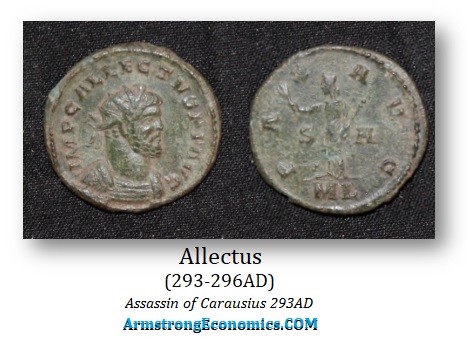Allectus
Usurper in Britain
293-296AD
Allectus was the chief finance minister (rationalis) to Carausius. Allectus was a very ambitious man. In 293 AD, he was the principal instigator in a plot that ended with the assassination of Carausius. Allectus was said to have been an excellent sailor and soldier. His domain included Britain and parts of Gaul. For three years, he ruled supreme over his newly acquired empire. However, Carausius may have defeated Maximian and appeared to have stabilized his British empire, but in fact, the forces of Rome were still waiting for the right moment.
Constantius I Chlorus (father of Constantine the Great) was raised to the rank of Caesar and, as such, was quite eager to prove himself. Constantius set his goal as the recovery of Britain, which came within his particular area of responsibility within the Tetriarchy. In 296 AD, Constantius set sail for Britain with two Roman fleets in pursuit of his enemy. Allectus reached Britain first after fleeing Gaul. He disembarked in preparation for the coming battle. Near Hampshire, the two forces clashed. Allectus‘ legions were routed, and shortly after that, he was killed. The triumph greatly enhanced the status of Constantius within Rome, for he had accomplished what Maximian could not.
Monetary System
Mints: London – Aureus, Billion Denarius, Antoninianus, Quinarius, Clausentum – Antoninianus, Quinarius
The identity of the C (sometimes CL) mint, which struck Carausius and Allectus, is still in considerable dispute. Camulodunum (Colchester) was believed to be the most likely choice. However, on the south coast, there was another stronghold of importance – Clausentum (Bitterne). Clausentum was used as a base by the Channel Fleet in defense of Britain. This lends considerable weight to this alternative attribution for the “C” mint mark, given that mints were normally associated with military concentrations. There does remain yet a third possibility for this mysterious mint – Glevum (Gloucester). However, the mint mark would most likely read “G” or “OL” if this attribution were correct. The strongest candidate is the city of Clausentum since this mint, unlike London, did not survive the defeat of the rebel state. To date, no gold coins have been discovered with this mint mark.
London mint marks are “ML” and are found on most denominations. Such mint marks thus identify coins of Carausius and Allectus as among the first British coins minted during the Roman era.
Monetary Reform
Allectus issued gold aurei, billon (debased silver)denarius, bronze antoniniani, and a smaller radiate denomination, usually termed “quinanus.” It is clear that while Carausius was the first to reintroduce a silver coinage known as the denarius, it was most likely valued significantly higher than the greatly depreciated antoninianus. Allectus appears to have begun the debasement of this denomination under Carausius, given that he was finance minister. Coinage, bearing his own name, presented yet another indication that economic conditions were far from stable in the new rebel state. The billion denarii is severely debased, falling once again in silver content to less than 50%. It is also possible that the radiate “quinarius” is the monetary equivalent of the half-antoninianus. Suppose the silver denarius was valued much more than the antoninianus; a bronze half-antoninianus would need to be issued. Therefore, this new radiate bust denomination might be more properly termed “restored bronze denarius” rather than as a “quinarius.”
DENOMINATIONS
AU Aureus (4.56 grammes)
AR Denarius (4.62-3.35 grammes)
Æ Antoninianus
Æ Half-Antoninianus (Quinarius)






